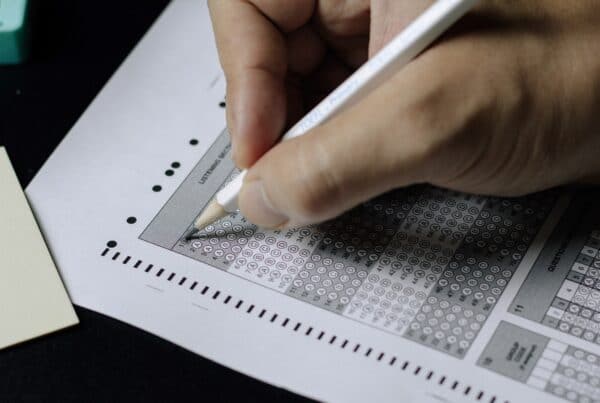Last Updated On: July 1st, 2024
When comparing the CBEST and the CSET Multiple Subject tests, first of all you must remember that these are two very different tests. While there are some similarities that you can use because they both will have multiple choice questions and cover some overlapping material, their differences far outweigh any similarities. You will be better prepared to work with these tests if you know the differences in their test plans.
Overall approach:
The CBEST tests for basic skills in three sections: Reading, Writing, and Mathematics. You will need to review topics in these categories if you have forgotten them over the years or if there are topics that you haven’t previously mastered. Familiarity in these topics will definitely help you in the CSET as well, so relearning these basics is time well spent.
The CSET tests for generalized understanding at a deeper level for topics covered in an elementary school setting. These tests cover a wider range of topics, and the questions asked are generally more demanding than the ones on the CBEST. The three subtests in the CSET Multiple Subjects test are Subtest 1: Reading, Language, and Literature; History and Social Science, Subtest 2: Science; Mathematics, and Subtest 3: Physical Education; Human Development; Visual and Performing Arts. The Multiple Subjects test is 5 hours if done all together. There is a separate CSET Writing test.
Scoring:
The CBEST requires a total of 123 points for the three sections, with no section dropping below a 37. You need to average 41 points per section, but a score between 37 and 41 is fine on a section, if you make up for it in another section. For example, if you have a weakness in writing, you can make up for it with your math, but you still need to perform well enough on the writing test to at least earn a 37. The CBEST is one of the worst tests to try to self-score for practice tests. The questions on the CBEST are weighted differently so that a certain percent on a practice test does not easily equate to a CBEST score. If you fall below the 37 points needed, or if you fall below 123 overall, you can retake a section to boost your score.
The CSET is graded by Subtest, and you need to pass all three subtests. A pass on the CSET is roughly 65-70% of the multiple-choice questions correct and an average of a 2 (+++) on the constructed response questions. If you do not receive a Pass on a Subtest, you can retake it, but you need to retake the whole Subtest. If you did not Pass Subtest 1 and did well on history but poorly on english, you still need to retake the entire Subtest 1; you cannot just retake the english section.
Questions:
The CBEST makes a nice warm-up for the CSET. The questions are typically straightforward, checking your understanding and use of these standard educational topics. There are fewer conceptually complicated questions. You will often see practical/real-life information in the word problems and charts.
Questions on the CSET can occasionally be simple, but they typically are more complicated than CBEST questions. Additionally, there are often answer choices that require careful consideration. For example, the CSET often has answer choices that make statements that are technically true, but that do not answer the question that was asked. The CSET also has questions that relate directly to the process of teaching the material in addition to questions that test the material itself. Finally, the CSET has constructed response questions, which are not seen on the CBEST.
Math:
The CBEST does not allow a calculator, so you will need to be able to perform calculations during this test. The CBSET math test is 2 hours long and contains only multiple-choice questions (50 of them). You must get a minimum of 37 points on this section, remembering that it is difficult to know how many questions will get you a 37, or better yet, a 41.
The CSET math section is combined with the Science section in Subtest 2, which is 3 hours long, if you do it on its own. The biggest benefit to CSET math is that you are allowed to have a basic calculator, so make sure you know when to use it and what strategies you can apply with it. The hardest part of the CSET math is that it is combined with the science section, and you must do well enough on the overall section to pass. If you are stronger in science than you are in math, this can be helpful, but the CSET science can be overwhelming with the variety of material that it covers. If you prepare well for your CBEST math, you will be able to apply much of that work to the CSET. The addition of calculator strategies will help make the math portion easier so you can spend your time studying a bit for math and a lot for the science section.
Another thing to remember is the constructed responses. In the math section, this comes in the form of solving problems while showing and explaining the steps that you took to solve the problems. In the science section, you will answer questions about scientific topics while explaining how and why you answered as you did, and using as many appropriate scientific terms as you can.
Reading:
The reading in the CBEST includes many organizational passages such as tables of content, recipes, and instructions. There are also standard fiction and nonfiction passages. This section has 50 multiple choice questions and is timed at an hour and a half.
The reading comprehension section of the CSET is only one of three content standards in the English half of Subtest 1, which is 3 hours long, if you take it on its own. The other entire half of the section is history. Like the science section, the history section is intense, with questions from California, American, and World histories. So, while reading comprehension is an entire section of the CBEST, it only applies to 1/6 of the CSET Subtest 1. Additionally, the passages in the CSET are less likely to be instruction manuals and more likely to be poetry and fables. Subtest 1 has 52 multiple choice questions, 26 from English and 26 from history.
A useful side note is that the English subsection of the test shares some materials with the RICA (The Reading Instruction Competence Assessment). While this section is as small as the reading comprehension section, if you are prepping for the RICA, it works well to study for it while you are studying for CSET Subtest 1 due to this overlap.
There are 4 constructed response questions in Subtest 1, two from the English section and two from the history section. The constructed responses for reading comprehension require an analytical response to the questions asked with direct support from the passage provided and explanations using literary terms.
Writing:
Writing is one of the three sections of the CBEST. In this section, you must compose two essays. The first essay will be a persuasive essay where you will support an opinion with a well-organized essay containing specific and relevant supporting arguments. The second essay will relate to a personal experience, and you will reflect on and support the relevance of your personal experience. In both essays you will be expected to write with correct grammar, punctuation, and syntax. Additionally, your essays will need to be well organized, and your thesis and topic paragraphs will need to be well supported. You have an hour and a half for these two essays, so you will be writing to the best of your ability in a limited time, which is understood by the graders of your exam.
The CSET Multiple Subject test does not have a writing section. The writing that is done in the subtests of this exam is done in the constructed response questions. These questions are not scored based on writing skill, not even in Subtest 1, which includes English topics. As long as the responses are clear enough to show purpose, support, and subject matter knowledge, you are fine. If you are taking the CSET Writing test, you will be writing essays, however. The essays for the CSET Writing exam are similar in nature to the CBEST. Again, you will have one essay dedicated to supporting an opinion on topics presented in the writing prompt and one essay relating to a personal experience. Like the CBEST, you have an hour and a half for these two essays, so you will be writing to the best of your ability in a limited time, which is understood by the graders of your exam.
CSET Subtest 3:
The CBEST does not have a section that is comparable to the CSET Subtest 3, which is 2 hours and 15 minutes long, if you do it on its own. This CSET section is generally the most approachable of the sections. In addition to only 39 multiple choice questions, it only has three constructed response questions. Human Development and PE are often more familiar, due to the latest study of them in a recent educator program. Challenges in this section can exist if you do not have a basic background in any of the arts; music is the most common hole. The art section of this test is generally more focused on major ideas, though, which can be more easily gained than the large quantities of knowledge needed for the science or history sections. Occasionally a specific question will be found in the art section that is not related to a major theme in the field, but these occur seldom and not in quantities that would lead to not passing.
The CBEST and the CSET Multiple Subject tests, although both important tests, are structured and approached very differently. Prepare for your CBEST, then prepare for your CSETs, and remember to use all of your resources. Preparation and practice will support your success in the testing portion of your journey to your credential!
Photo by LinkedIn Sales Solutions on Unsplash




















